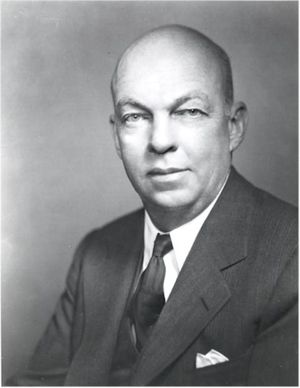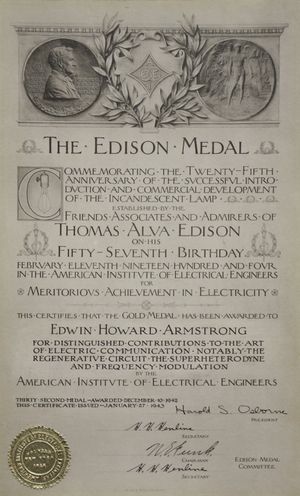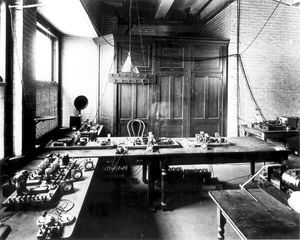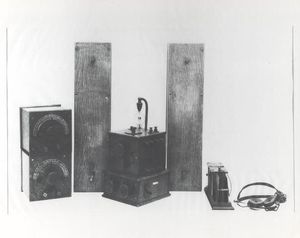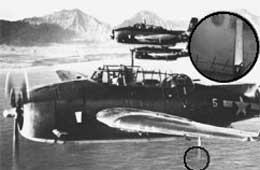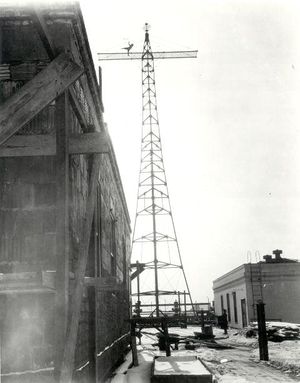Edwin H. Armstrong: Difference between revisions
No edit summary |
No edit summary |
||
| (33 intermediate revisions by 10 users not shown) | |||
| Line 1: | Line 1: | ||
[[Image: | {{Biography | ||
|Image=Edwin Armstrong 0251.jpg | |||
|Birthdate=1890/12/18 | |||
|Birthplace=New York, NY, USA | |||
|Death date=1954/01/31 | |||
|Fields of study=[[Radio]] | |||
|Awards=AIEE Edison Medal (renamed the [[IEEE Edison Medal]]); IRE Medal of Honor (renamed the [[IEEE Medal of Honor]]) | |||
}} | |||
[[Image:Edison medal.jpg|thumb|right|Edwin H. Armstrong's Edison Medal, awarded in 1942. Photo: Antique Wireless Association Museum, loaned from the Historical and Interpretive Collections of The Franklin Institute, Inc., Philadelphia, PA.]] | |||
[[Image:3341-armstrong lab at columbia.jpg|thumb|right|Armstrong's Lab at Columbia]] | |||
[[Image:Armstrong regenerative radio 0452.jpg|thumb|right|Armstrong Regenerative Radio]] | |||
[[Image: | [[Image:Armstrongradiobeach.jpg|thumb|right]] | ||
[[Image:Armstrong on WJZ Transmitter 0257.jpg|thumb|right|Armstrong on WJZ Transmitter]] | |||
Armstrong | Edwin Howard Armstrong is widely regarded as one of the foremost contributors to the field of [[Radio|radio-electronics]]. Among his principal contributions were regenerative feedback circuits, the [[Superheterodyne Receiver|superheterodyne radio receiver]], and a [[FM Radio|frequency-modulation radio broadcasting system]]. He was inducted into the National Inventors Hall of Fame in 1980. | ||
Armstrong was born on the upper west side of Manhattan, New York City, on 18 December 1890, the oldest child of prosperous and devoutly Presbyterian parents. [[Radio|Radio]] became Armstrong's passion when he learned that Guglielmo Marconi had invented a wireless telegraph in his back yard; Armstrong built his own station and 30-meter tall antenna. | |||
In 1909 he began studying electrical engineering at Columbia University under the celebrated professor [[Michael Pupin|Michael J. Pupin]]. About a year before he graduated in 1913, he devised a circuit that revolutionized radio technology. Using a triode as an amplifier, he fed back part of the output to the input, and thereby obtained much greater amplification. Armstrong made a further discovery with this circuit: just when maximum amplification was obtained, the signal changed suddenly to a hissing or a whistling. He realized this meant that the circuit was generating its own oscillations, and thus that the triode could be used as a frequency generator. The first of these discoveries — of a powerful amplifier — vastly increased the sensitivity of radio receivers to distant stations, while the second — of an oscillator — led to the use of the electron tube in transmitters and also in receivers for an added function, heterodyne reception. | |||
[[Category:Communications]] [[Category: | In 1901, [[Reginald A. Fessenden|Reginald Fessenden]] had introduced to radio the heterodyne principle: if two tones of frequencies A and B are combined, one may hear a tone with frequency A minus B. Armstrong used this principle in devising what came to be called the [[Superheterodyne Receiver|superheterodyne receiver]]. The essential idea is to convert the high-frequency received signal to one of intermediate frequency by heterodyning it with an oscillation generated in the receiver, then amplifying that intermediate-frequency signal before subjecting it to the detection and amplification usual in receivers. [[RCA (Radio Corporation of America)|RCA]] marketed the superheterodyne beginning in 1924, and soon licensed the invention to other manufacturers. It became — and remains today — the standard radio reception circuit. | ||
In the early 1920s, Armstrong turned his attention to what seemed to him, and to many other radio engineers, as the greatest problem, namely, the elimination of static. He wrote, "This is a terrific problem. It is the only one I ever encountered that, approached from any direction, always seems to be a stone wall." Armstrong eventually found a solution in frequency modulation, which is a different way of impressing an audio signal on a radio-frequency carrier wave. In the usual technique, known as amplitude modulation (AM), the amplitude of the carrier wave is regulated by the amplitude of the audio signal. With frequency modulation, the audio signal alters instead the frequency of the carrier, shifting it down or up to mirror the changes in amplitude of the audio wave. He soon found it necessary to use a much broader bandwidth than AM stations used (today an [[FM Radio|FM radio]] channel occupies 200 kHz, twenty times the bandwidth of an AM channel), but doing so gave not only relative freedom from static but also much higher sound-fidelity than AM radio offered. | |||
With the four patents for his FM techniques that he obtained in 1933, Armstrong set about gaining the support of RCA for his new system. RCA engineers were impressed, but the sales and legal departments saw FM as a threat to RCA and the National Broadcasting Company (NBC) relationship with AM radio stations. [[David Sarnoff|David Sarnoff]], the president of RCA, had already decided to promote television vigorously and knew the company and the stations did not have the resources to develop or implement a new radio system at the same time. Moreover, in the economically distressed 1930s, there was even less popular demand for better sound quality, so there was not thought to be a large market for products offering it. | |||
Armstrong gained some support from [[General Electric (GE)|General Electric]] and Zenith Radio Corporation, but he carried out the development and field testing of a practical FM broadcasting system largely on his own. He gradually gained the interest of engineers, broadcasters, and radio listeners, and in 1939 about twenty experimental stations were broadcasting FM. These stations could not, according to FCC rules, sell advertising or derive income in any other way from broadcasting, but finally, in 1940, the FCC decided to authorize commercial FM broadcasting, allocating the region of the spectrum from 42 MHz to 50 MHz to forty FM channels. In October 1940, it granted permits for fifteen stations. Zenith and other manufacturers marketed FM receivers, and by the end of 1941, nearly 400,000 sets had been sold. | |||
U.S. entry into World War II brought a halt both to the granting of licenses for FM stations and to the production of FM receivers. During the war, Armstrong experimented with the use of FM radio for radar purposes at Camp Evans in New Jersey. He modified an SCR-271 radar and created an experimental FM doppler radar system that operated on a narrow receiver bandwidth in sync with the transmitter. Although abandoning the radar to return to his battle for FM radio, his system was modified for use in Project Diana's bounce of a radar signal off the Moon. | |||
After the war, FM broadcasting was dealt a severe blow when the FCC moved the FM spectrum allocation to 88 to 108 MHz and thus making obsolete the 400,000 receivers. This allocation, however, allowed for two and a half times as many channels, and the FM industry slowly recovered, though it did not enjoy rapid growth until the late 1950s. In the late 1970s, FM broadcasting surpassed AM in share of the radio audience, and by the end of the twentieth century, its share was triple that of AM broadcasting. | |||
Among the many honors Armstrong received were the [[IEEE Edison Medal|Edison Medal]] of the [[AIEE History 1884-1963|American Institute of Electrical Engineers (AIEE)]] and the [[IEEE Medal of Honor|Medal of Honor]] of the [[IRE History 1912-1963|Institute of Radio Engineers (IRE)]]. These were the highest honors of those two predecessor organizations of the [[IEEE History|IEEE]]. Sadly, the last years of Armstrong's life were darkened by continual patent litigation, and he committed suicide on 31 January 1954. | |||
==Further Reading== | |||
[[Media:Armstrong letters.pdf|1949 and 1953 correspondence from Edwin Armstrong (signed) to Lawrence Lessing of Fortune magazine]] | |||
[[Media:Eitel Armstrong 817.pdf|Eitel & Armstrong transcript #817.pdf]] | |||
Armstrong's papers are held by Columbia University, where thanks to the efforts of Professor Emeritus (and IEEE Life Fellow) [[Mischa Schwartz]], and a grant from the IEEE Foundation, they were processed in 2010 to make them more accessible to future scholars. [http://www.nytimes.com/2010/04/19/business/media/19archives.html?scp=1&sq=Saving%20the%20Neglected%20History&st=cse A New York Times article] gave this project, and thereby Armstrong's life, well deserved attention. [http://findingaids.cul.columbia.edu/ead/nnc-rb/ldpd_4078687/summary There is a published finding aid to the collection.] | |||
The ETHW also contains a [https://ethw.org/Technical_tour_EHArmstrong Self-Guided tour of sites associated with Armstrong]. | |||
{{DEFAULTSORT:Armstrong}} | |||
[[Category:Communications]] | |||
[[Category:Receivers]] | |||
[[Category:Radio_broadcasting]] | |||
Latest revision as of 14:48, 27 February 2023
- Birthdate
- 1890/12/18
- Birthplace
- New York, NY, USA
- Death date
- 1954/01/31
- Fields of study
- Radio
- Awards
- AIEE Edison Medal (renamed the IEEE Edison Medal), IRE Medal of Honor (renamed the IEEE Medal of Honor)
Biography
Edwin Howard Armstrong is widely regarded as one of the foremost contributors to the field of radio-electronics. Among his principal contributions were regenerative feedback circuits, the superheterodyne radio receiver, and a frequency-modulation radio broadcasting system. He was inducted into the National Inventors Hall of Fame in 1980.
Armstrong was born on the upper west side of Manhattan, New York City, on 18 December 1890, the oldest child of prosperous and devoutly Presbyterian parents. Radio became Armstrong's passion when he learned that Guglielmo Marconi had invented a wireless telegraph in his back yard; Armstrong built his own station and 30-meter tall antenna.
In 1909 he began studying electrical engineering at Columbia University under the celebrated professor Michael J. Pupin. About a year before he graduated in 1913, he devised a circuit that revolutionized radio technology. Using a triode as an amplifier, he fed back part of the output to the input, and thereby obtained much greater amplification. Armstrong made a further discovery with this circuit: just when maximum amplification was obtained, the signal changed suddenly to a hissing or a whistling. He realized this meant that the circuit was generating its own oscillations, and thus that the triode could be used as a frequency generator. The first of these discoveries — of a powerful amplifier — vastly increased the sensitivity of radio receivers to distant stations, while the second — of an oscillator — led to the use of the electron tube in transmitters and also in receivers for an added function, heterodyne reception.
In 1901, Reginald Fessenden had introduced to radio the heterodyne principle: if two tones of frequencies A and B are combined, one may hear a tone with frequency A minus B. Armstrong used this principle in devising what came to be called the superheterodyne receiver. The essential idea is to convert the high-frequency received signal to one of intermediate frequency by heterodyning it with an oscillation generated in the receiver, then amplifying that intermediate-frequency signal before subjecting it to the detection and amplification usual in receivers. RCA marketed the superheterodyne beginning in 1924, and soon licensed the invention to other manufacturers. It became — and remains today — the standard radio reception circuit.
In the early 1920s, Armstrong turned his attention to what seemed to him, and to many other radio engineers, as the greatest problem, namely, the elimination of static. He wrote, "This is a terrific problem. It is the only one I ever encountered that, approached from any direction, always seems to be a stone wall." Armstrong eventually found a solution in frequency modulation, which is a different way of impressing an audio signal on a radio-frequency carrier wave. In the usual technique, known as amplitude modulation (AM), the amplitude of the carrier wave is regulated by the amplitude of the audio signal. With frequency modulation, the audio signal alters instead the frequency of the carrier, shifting it down or up to mirror the changes in amplitude of the audio wave. He soon found it necessary to use a much broader bandwidth than AM stations used (today an FM radio channel occupies 200 kHz, twenty times the bandwidth of an AM channel), but doing so gave not only relative freedom from static but also much higher sound-fidelity than AM radio offered.
With the four patents for his FM techniques that he obtained in 1933, Armstrong set about gaining the support of RCA for his new system. RCA engineers were impressed, but the sales and legal departments saw FM as a threat to RCA and the National Broadcasting Company (NBC) relationship with AM radio stations. David Sarnoff, the president of RCA, had already decided to promote television vigorously and knew the company and the stations did not have the resources to develop or implement a new radio system at the same time. Moreover, in the economically distressed 1930s, there was even less popular demand for better sound quality, so there was not thought to be a large market for products offering it.
Armstrong gained some support from General Electric and Zenith Radio Corporation, but he carried out the development and field testing of a practical FM broadcasting system largely on his own. He gradually gained the interest of engineers, broadcasters, and radio listeners, and in 1939 about twenty experimental stations were broadcasting FM. These stations could not, according to FCC rules, sell advertising or derive income in any other way from broadcasting, but finally, in 1940, the FCC decided to authorize commercial FM broadcasting, allocating the region of the spectrum from 42 MHz to 50 MHz to forty FM channels. In October 1940, it granted permits for fifteen stations. Zenith and other manufacturers marketed FM receivers, and by the end of 1941, nearly 400,000 sets had been sold.
U.S. entry into World War II brought a halt both to the granting of licenses for FM stations and to the production of FM receivers. During the war, Armstrong experimented with the use of FM radio for radar purposes at Camp Evans in New Jersey. He modified an SCR-271 radar and created an experimental FM doppler radar system that operated on a narrow receiver bandwidth in sync with the transmitter. Although abandoning the radar to return to his battle for FM radio, his system was modified for use in Project Diana's bounce of a radar signal off the Moon.
After the war, FM broadcasting was dealt a severe blow when the FCC moved the FM spectrum allocation to 88 to 108 MHz and thus making obsolete the 400,000 receivers. This allocation, however, allowed for two and a half times as many channels, and the FM industry slowly recovered, though it did not enjoy rapid growth until the late 1950s. In the late 1970s, FM broadcasting surpassed AM in share of the radio audience, and by the end of the twentieth century, its share was triple that of AM broadcasting.
Among the many honors Armstrong received were the Edison Medal of the American Institute of Electrical Engineers (AIEE) and the Medal of Honor of the Institute of Radio Engineers (IRE). These were the highest honors of those two predecessor organizations of the IEEE. Sadly, the last years of Armstrong's life were darkened by continual patent litigation, and he committed suicide on 31 January 1954.
Further Reading
1949 and 1953 correspondence from Edwin Armstrong (signed) to Lawrence Lessing of Fortune magazine
Eitel & Armstrong transcript #817.pdf
Armstrong's papers are held by Columbia University, where thanks to the efforts of Professor Emeritus (and IEEE Life Fellow) Mischa Schwartz, and a grant from the IEEE Foundation, they were processed in 2010 to make them more accessible to future scholars. A New York Times article gave this project, and thereby Armstrong's life, well deserved attention. There is a published finding aid to the collection.
The ETHW also contains a Self-Guided tour of sites associated with Armstrong.
